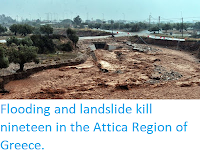The United States Geological Survey recorded
a Magnitude 5.1 Earthquake at a depth of 6 km, in the Eastern Macedonia and Thrace Region of Greece, slightly before 6.25 am local time (slightly before 4.25 am GMT) on Tuesday 2 January 2018. No damage or injuries have been
reported following this event, but people have reported feeling the
event from much of northeastern Greece, eastern Macedonia and southwest and Bulgaria.
The approximate location of the 2 January 2018 Greek Earthquake. USGS.
The Aegean Sea is underlain by the Aegean Sea Plate, a small tectonic
plate caught between the African Plate to the south, the Anatolian Plate
to the east and the Eurasian Plate to the northwest. The Anatolian
Plate is being pushed to the west by the northward movement of the
Arabian Plate to the east, pushing the Aegean Plate south and west into
collision with the northward moving African Plate. Part of the African
Plate is being subducted beneath the Aegean Plate along the Hellenic
Trench, which runs to the south of the Greek Islands from Cyprus to
Crete then northwest under the Ionian sea parallel to the Peloponnesian
Coast. This is not a smooth process, as the plates frequently stick together
then break apart once the pressure has built up sufficiently, leading to
(fairly frequent) Earthquakes.
Simplified map of the plate movements of the eastern Mediterranean. Univeriteit Utrecht.
See also...
Follow Sciency Thoughts on Facebook.








